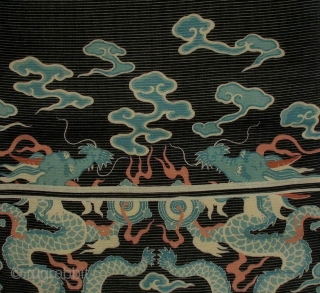Back
Silk Dragon Obi, Japan, Meiji (circa 1880), cm 292x32. The ‘obi’ is a sash for traditional Japanese dresses, and a part of kimono outfits. This one is a so-called ‘nagoya obi’, a shorted than usual obi that was mostly used by young, unmarried women. It is made of ‘ro’ silk, a very light, sheer, gauze-like fabric (kinda spider silk) with a loose open mesh weave. The secret of these open weave fabrics is the twisting of their fine warp threads in pairs. The weft threads are inserted between the twists, forming an open weave that is strong, beautiful, and cool. This lightweight silk is used for weavings worn during the summer months, and its very peculiar structure is seen at best in the detail image taken with flash light. So far the technique. Truly amazing, though, are the dragons decorating this very smart sash, with designs of clear Chinese influence that reminds the best Ming textiles from that land, rendered with a Japanese colour palette. In excellent condition it should have spent most of the past 130 years carefully folded in a drawer and used only on special occasions. Very recommended.
price:
SOLD
- Home
- Antique Rugs by Region
- Category
- Profiles
- Post Items Free
- Albums
- Benaki Museum of Islamic Art
- Budapest: Ottoman Carpets
- Gulbenkian Museum
- Islamic Carpets. Brooklyn
- Islamic Textiles. Brooklyn
- Konya Museum: Rugs
- MKG, Hamburg
- MMA: Caucasian Carpets
- MMA: Mamluk Carpets
- MMA: Mughal Indian Carpets
- MMA: Ottoman Carpets
- MMA: Safavid Persian Carpets
- MMA: Turkmen Rugs
- McCoy Jones Kilims
- Ottoman textiles. Met
- Philadelphia Museum
- Rugs and Carpets: Berlin
- Seljuqs at the Met
- TIEM, Istanbul: Carpets
- V&A: Classical Carpets
- Vakiflar Carpets: Istanbul
- Baluch Rugs: Indianapolis
- Gallery Exhibitions
- Jaf an Exhibition
- Alberto Levi Gallery
- Andean Textile
- Christie's London: 2016
- Francesca Galloway
- HALI at 40
- ICOC Washington, DC 2018
- Jajims of the Shahsavan
- London Islamic Week April, 2018
- Mongolian Felts
- Navajo Rugs: JB Moore
- Persian Piled Weavings
- SF Tribal & Textile Art Show 2020
- SF Tribal 2019
- Sotheby's: C. Alexander
- Turkish Prayer Rugs
- Turkmen Main Carpets ICOC 2007











